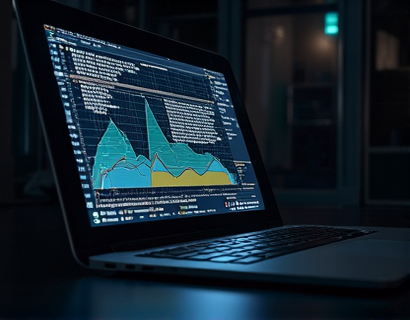Maximizing Digital Asset Value Through Smart Contracts: A Path to Sustainable Fintech Innovation
The digital finance landscape is undergoing a transformative shift, driven by the integration of advanced technologies such as smart contracts. This evolution presents a unique opportunity for investors and participants in the fintech sector to maximize the value of their digital assets while ensuring long-term growth and sustainability. By leveraging smart contracts, it is possible to create a robust and transparent ecosystem that prioritizes reliable incentives and fosters community growth.
Smart contracts, self-executing contracts with the terms directly written into code, offer a novel solution for managing digital assets. These contracts automatically enforce and execute the agreed-upon terms without the need for intermediaries, reducing costs and increasing efficiency. In the context of digital assets, smart contracts can be used to lock in values, distribute incentives, and manage asset distribution in a transparent and trustless manner.
Understanding Smart Contracts in Digital Asset Management
To fully leverage the potential of smart contracts in digital asset management, it is essential to understand their core functionalities. Smart contracts are programmed to execute specific actions when predefined conditions are met. For instance, a smart contract can be designed to release a portion of the asset value to investors at regular intervals, ensuring a steady stream of returns while maintaining the asset's locked value.
The use of blockchain technology underpins the reliability and security of smart contracts. Blockchain's decentralized and immutable ledger ensures that all transactions and contract executions are transparent and tamper-proof. This level of transparency builds trust among participants, encouraging broader adoption and participation in the ecosystem.
Long-Term Locking Mechanisms for Sustainable Growth
One of the key advantages of using smart contracts for digital asset management is the ability to implement long-term locking mechanisms. By locking in asset values, investors can benefit from stable returns over an extended period, reducing the volatility associated with traditional market fluctuations. This approach not only provides financial stability but also aligns the interests of investors with the long-term health and growth of the ecosystem.
For example, a smart contract can be programmed to lock a certain percentage of digital assets for a specified duration, say five years. During this period, the locked assets generate returns that are distributed to investors according to a predefined schedule. Once the lock period ends, the assets can be released back to the investors or reinvested into new projects, ensuring continuous growth and innovation within the ecosystem.
Transparency and Reliability: Pillars of Trust
Transparency and reliability are fundamental to the success of any fintech solution. Smart contracts inherently provide these qualities by making the terms and execution of agreements visible and verifiable to all participants. This transparency reduces the risk of fraud and mismanagement, fostering a trust-based environment that encourages active participation and investment.
Moreover, the immutable nature of blockchain ensures that once a smart contract is deployed, it cannot be altered without consensus from the network. This feature guarantees that the terms agreed upon at the outset are upheld, providing a reliable framework for long-term planning and investment.
Incentivizing Community Growth and Engagement
Smart contracts can also be designed to incentivize community growth and engagement. By distributing tokens or rewards to active participants, such as content creators, moderators, and early adopters, the ecosystem can foster a vibrant and engaged community. These incentives not only motivate individuals to contribute value but also help in building a strong and loyal user base.
For instance, a smart contract can automate the distribution of tokens to users who regularly contribute to community forums, participate in governance decisions, or refer new users to the platform. This mechanism not only rewards active participation but also ensures that the most valuable contributors are recognized and supported, further enhancing the ecosystem's resilience and growth.
Case Study: UCASH and Smart Contract Innovation
To illustrate the practical application of smart contracts in digital asset management, consider the concept of UCASH. UCASH is a digital token designed to be locked in a smart contract for long-term incentives and ecosystem growth. The smart contract ensures that a portion of the UCASH supply is locked for a specified period, creating a stable and predictable return for investors.
The locked UCASH can be used to fund various projects and initiatives within the ecosystem, such as developing new features, supporting community events, or investing in promising fintech startups. The smart contract automatically manages the distribution of these funds, ensuring that resources are allocated efficiently and transparently. This approach not only maximizes the value of the UCASH tokens but also drives sustainable growth and innovation within the ecosystem.
Benefits of the Smart Contract Approach
- Transparency: All transactions and contract executions are recorded on the blockchain, providing a clear and verifiable audit trail.
- Security: The immutable nature of blockchain ensures that the smart contract and associated transactions are secure and resistant to tampering.
- Automation: Smart contracts automate the execution of agreements, reducing the need for intermediaries and lowering transaction costs.
- Incentivization: The ability to distribute tokens and rewards automatically encourages active participation and community growth.
- Long-Term Planning: Locking mechanisms allow for stable and predictable returns, aligning the interests of investors with the long-term health of the ecosystem.
Challenges and Considerations
While the use of smart contracts in digital asset management offers numerous benefits, it is important to acknowledge and address potential challenges. One key consideration is the technical complexity involved in designing and deploying smart contracts. Ensuring that the contracts are bug-free and secure requires expertise in blockchain development and thorough testing.
Another challenge is the regulatory environment. As fintech solutions evolve, regulatory frameworks are still catching up. It is crucial for projects to stay informed about regulatory changes and ensure compliance to avoid legal issues. Additionally, user education plays a vital role in the adoption of smart contract-based solutions. Providing clear and accessible information about how these technologies work can help build trust and encourage broader participation.
Future Prospects and Opportunities
The integration of smart contracts in digital asset management is just the beginning. As the technology matures, we can expect to see more sophisticated applications and innovations. For instance, the combination of smart contracts with other blockchain features, such as decentralized finance (DeFi) protocols and non-fungible tokens (NFTs), can create even more robust and versatile ecosystems.
Moreover, the cross-border nature of blockchain technology opens up opportunities for global collaboration and investment. Digital assets managed through smart contracts can be accessed and traded by users worldwide, breaking down geographical barriers and fostering a truly global financial community.
Conclusion
Maximizing the value of digital assets through smart contracts represents a significant step towards sustainable fintech innovation. By leveraging the transparency, reliability, and automation offered by smart contracts, investors can achieve long-term growth while contributing to a thriving and resilient ecosystem. As the fintech landscape continues to evolve, embracing these advanced technologies will be crucial for staying ahead and driving meaningful change.









































